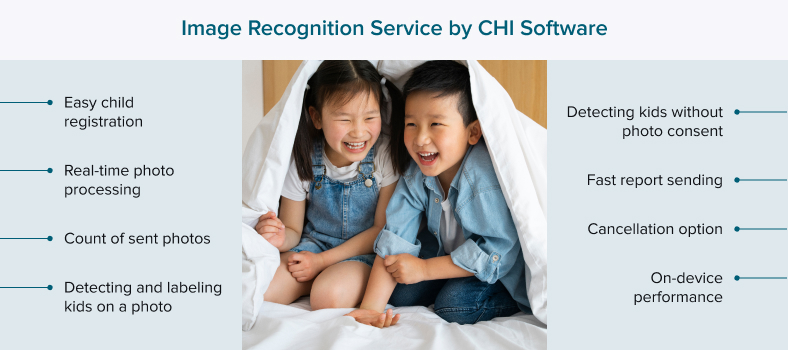2024 is the year of the Olympic Games in Paris. Millions of tourists will gather to watch top athletes competing, and image recognition will be a special guest at the events for the sake of security.
You can experience image recognition even if you are not visiting Paris this year. The technology has many applications in healthcare, retail, and transportation. Our AI/ML team selected the top image recognition trends for 2024 to foresee what innovations will come soon.
Image Recognition Service: Practical Insights
First, let us look at our client’s case and show you how businesses can benefit from image recognition advancements.
Children in Japan attend preschool between the ages of 0 and 5 and stay there for long hours during all weekdays. To stay informed, parents receive regular formal reports about kids’ behavior and activities.
Our client decided to go further and introduce photo reports to show how kids spend their time. In this case, an AI-powered image recognition application is the best way to make timely and accurate updates.
Seeing Through the Machine’s Eyes: Top Challenges in Image Recognition
Read more
Project Background: Challenges Mirroring Trends in Image Recognition
Our team worked on this case from the very beginning. During the project, we faced several challenges that are typical for the domain. The experience of solving them gave us insights that reflect current image recognition trends and can be used for similar solutions.
Challenge 1: Image Recognition Accuracy and Speed
Our main task was developing a fast and precise image recognition tool to detect many faces at once.
Trend 1: Integration of Deep Learning and Neural Networks
When working together, deep learning algorithms and neural networks enable more accurate object detection and classification, faster data processing, and better pattern analysis. The combination of these technologies efficiently mimics the human brain’s ability to learn from data and interpret it.

Challenge 2: On-Device App Logics
Our app has no backend part; all operations should occur locally. So, we needed to find a neural network that effectively does the job on-device. After testing ten options, we succeeded in finding one!
Trend 2: Edge Computing Integration
Edge computing is about processing data closer to where it is generated. Image recognition tools use this approach for quick decisions on the spot, without sending it to backend servers. For example, security cameras utilize on-device image processing to recognize visitors at your door, and self-driving cars employ it for navigation.
What about image recognition in vehicle damage detection? We have something to tell about that
Read more
Challenge 3: Respecting Privacy
Safeguarding personal privacy is a big challenge in the image recognition world. One of the project essentials was protecting the privacy of children whose parents did not consent to photography. These toddlers should not be visible in any shared photos.
Trend 3: Privacy-Preserving Methods
Today, developers can use different techniques for privacy protection. Anonymization, for instance, helps quickly detect and blur faces or figures to keep identities hidden. Homomorphic encryption allows AI algorithms to analyze coded images that are unrecognizable to the human eye. Federated learning enables ML models to learn from data across multiple devices.
More Details on the Solution’s Workflow
As a result, we have developed a user-friendly mobile app for photo reporting. With this tool, teachers and tutors can easily add a new kid to the system, automatically select photos to send, and track the number of images that each kid’s parents receive.
Our solution also filters out images of kids whose parents do not allow photo-taking and excludes their images from reports.

Discover the full story of this solution in our comprehensive case study!
How This Solution Will Impact Business Processes
We completed the project in four months, yielding impressive technical and business results. Here they are:
- On-device AI efficiency: Our app works quickly and accurately on mobile devices. Finding a neural network that could do the job was a real challenge, but we made it!
- Fast image recognition: The solution processes and recognizes up to five faces in 3/4 seconds in real time;
- High accuracy and consistency: Our model achieves an F1 score of 85%, which means it is doing a great job;
- Easy registration: This user-friendly feature lets teachers effortlessly add a new child’s account to the database;
- Optimized reporting: The solution allows preschool assistants to send daily photo reports without any delay.
4 More Image Recognition Trends and Applications for 2024
Our project showed us some up-and-coming trends in image recognition for the year ahead. But our project is just a drop in the image recognition ocean. What else is there? Let us find out.
Advanced Real-Time Image Recognition
Real-time image recognition acts like a super-fast robot that can instantly name things it sees through the camera of an autonomous vehicle or security system. As hardware and software become more sophisticated, the opportunities for this trend expand.
AR and VR Enhancements
Image recognition has taken augmented reality (AR) to new heights, creating highly immersive experiences. For example, students can now see ultra-realistic 3D models in classrooms, from prehistoric animals to famous people of the past. Can learning be more interactive? Similarly, virtual reality (VR) has vastly improved movement tracking and now offers more convincing virtual meetings and games with a stronger sense of presence in digital spaces.
Healthcare Application Expansion
In healthcare, AI reshapes approaches to medical imaging and diagnosis. Image recognition technologies allow machines to accurately interpret medical scans, like X-rays and MRIs, helping physicians identify illnesses quickly, track disease progression, and determine effective treatments. Image recognition apps also help improve accessibility for visually impaired patients.
Retail Applications
Image recognition revolutionizes e-commerce and physical retail by powering virtual try-ons for clothes and make-up, in-store shopper behavior analysis for personal recommendations, and real-time inventory tracking. In the near future, brick-and-mortar and online stores will see more innovations. We expect even faster checkouts, more efficient on-shelf product search, and smarter online product discovery.
What Is Next?
Image recognition has rapidly evolved. Numerous industries benefit from introducing image recognition to their operations, and your company can use it well, too.
If you have something in mind and would like to test your concept, you need a partner with technical expertise in the domain. At CHI Software, we have gathered a team of solid professionals in AI/ML who will be happy to help. So all you have to do is to reach out to us. Together, we’ll make your vision a reality.
FAQs
-
How has image recognition evolved by 2024?

Image recognition has considerably advanced by 2024, particularly by integrating deep learning algorithms that notably improve object detection and classification accuracy and speed.
-
What are the key trends in image recognition for 2024?

Current image recognition trends are centered around deep learning algorithms and neural networks for heightened precision and processing speed, edge computing for on-device real-time recognition, and AR/VR enhancements for immersive experiences. Healthcare sees more accurate diagnostic imaging, while retail benefits from virtual try-ons and behavioral analysis for shopping personalization.
-
How does AI enhance image recognition technologies?

Artificial intelligence boosts image recognition through advanced deep learning algorithms and improves speed and accuracy in object detection and image classification. It enables real-time processing, supports privacy with innovative encryption, and enhances user experiences in AR/VR.
-
What industries will be most impacted by image recognition in 2024?

The most revolutionized industries include healthcare, with AI-assisted medical imaging for early diagnosis and treatment planning; automotive, where image recognition is critical for developing autonomous vehicles; and retail, which uses image recognition for inventory management and personalized shopping experiences.
-
How does image recognition contribute to consumer technology?

People utilize image recognition daily, sometimes even not realizing it. For example, we use this tech every time they unlock mobile phones with face scans. Home security systems control access to a building with image recognition. Thanks to image recognition, we experience a mix of augmented reality and the physical world while playing games. In retail, image recognition helps people easily find a product online and on the shelf and try on clothes and makeup.
About the author
Alex Shatalov
Data Scientist & ML Engineer
Alex is a Data Scientist & ML Engineer with an NLP specialization. He is passionate about AI-related technologies, fond of science, and participated in many international scientific conferences.




